Maackia 003: Next steps
Hi! I’m an exhausted Nathan Langley and this is Maackia, a monthly newsletter where we talk about plants! (Promise.)
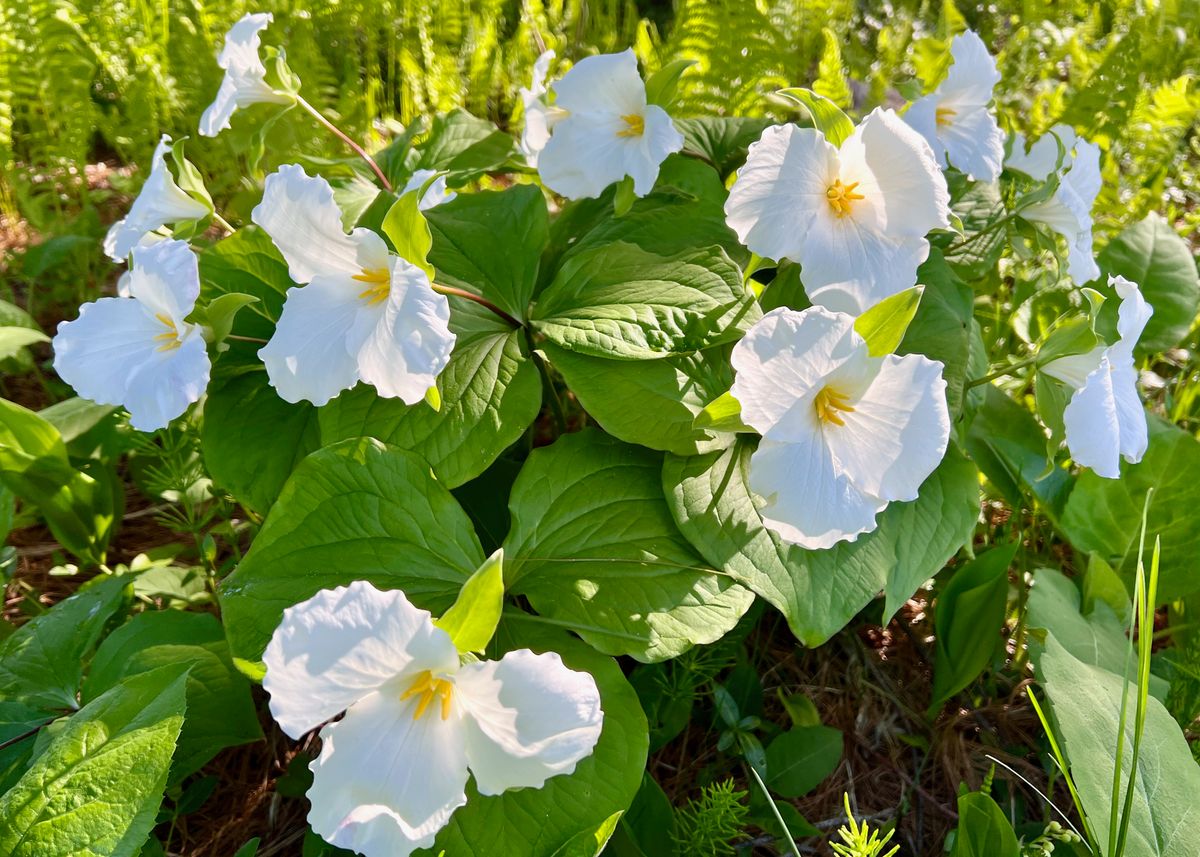
May is always the busiest month in my calendar, but this year was a little more exciting with Covid ripping through the house at the beginning of the month. Despite that setback, I have been otherwise focused on producing planting plans for various projects. Which, funny enough, has made me think about my design process and the gaps in knowledge that I need to work on filling.
I’m sure you would be shocked to learn that I love reading about industrial design. The overall process is fascinating and engaging as it is quick, impactful, and creative. Relative to garden design, anyway. Models are made, feedback is received and digested all within a short(ish) iterative process that builds on itself to produce something tangible and useable. Garden design isn’t really like that. Gardens take time to establish. Plants are alive and complex. Uncertainty is always present at some level even when you think everything has gone right and your job is finished (hint: your job is never finished). I enjoy the uncertainty and complexity of garden design and have become more comfortable sitting in a space of not knowing while I wait for plants to grow and flourish. But there are still parts of the industrial design process that I need to adapt to my own workflow. I need to get back to some gardening fundamentals.
During my last stint at school, plant knowledge wasn’t really taught. We had one course on tree identification (with a few shrubs sprinkled in), but that was largely it. There was nothing on perennials. The parts that weren’t taught were supposed to be picked up along the way during design courses. This seemed wrong to me because I came from a horticulture background. There is so much to know and learn about the plant world, and I thought getting your hands dirty and interacting directly with the plants was a better path to take than looking at them in a nursery catalogue. But it wasn’t practical within a traditional school setting.
Compared to industrial design, landscape architecture students are at a disadvantage. We didn’t work with the materials that are commonly associated with the profession during our education. We didn’t build models, assess, and iterate quickly. Most importantly, we couldn’t experience our designs. We just had to go by what our plan view and perspective drawings looked like. But they can never be more than an oversimplification of the real thing. Practice, practice, practice designing. Interact, interact, interact with the material. Every day. That’s what I have learned from industrial design.
With that in mind, I have decided to work on my horticulture skills again as landscape architecture in Sudbury doesn’t offer the kind of knowledge and experience I need to get better at the kind of work I want to do. It doesn’t really exist at all, to be honest.
Trial gardens aren’t a new idea, but I am convinced they are the best path forward towards increasing my experiential knowledge of plants that grow in my area. Currently, I can see the results of my work when gardens are installed, or I can go to a garden centre and look at all of their plants. But being around plants everyday and seeing them in different conditions is the next logical step. So I have started to buy plants without a plan. I will put them somewhere in my neglected gardens and I will see how they do and listen to what they have to share.
Here is what has been purchased so far:
- Aruncus dioicus
- Astilbe ‘Lowlands Ruby Red’
- Coreopsis ‘Moonbeam’
- Dianthus gratianopolitanus
- Hydrangea arborescens ‘Annabelle’
- Iris setosa var. arctica
- Papaver orientale
- Prunus spp. ‘Convoy’
- Prunus x kerrasis
- Saponaria ocymoides
- Weigela florida ‘Alexandra’
It’s nothing special, but it is a start. There will be more to come and I will share what I learn as I go. I’ll also start working on a garden plan for the driveway area this summer once things have calmed down. Hopefully.
the recipe
Shady Layers
Working with spaces on the North side of a house is a common issue clients ask me to tackle. There aren’t a lot of shade plants to choose from in a zone 3 or 4 hardiness zone, so gardens tend to look the same. With this recipe, I wanted to keep things simple and build a short to tall garden with something interesting happening in the fall. Textures are usually the main draw with shade plants as they tend to flower in spring and early summer. So I wanted to use a plant that typically grows in the bush.
Ingredients:
Hydrangea arborescens ‘Annabelle’
- white flowers in summer; zone 3
Aster divaricatus
- white flowers in fall; z3
Astilbe chinensis var. taquetti ‘Superba’
- pink flowers in late summer; z3
Brunnera macrophylla ‘Jack Frost’
- blue flowers in early spring; z4
Cimicifuga ramosa ‘Hillside Black Beauty’
- white flowers in summer; z3
Dicentra spectabilis
- pink flowers in spring; z3
Heuchera x ‘Black Pearl’
- white flowers in summer; z3
Hosta ‘Krossa Regal’
- pink/purple in summer; z3
Tiarella wherryi
- white flowers from late spring to early summer; z3
Seasons:
Overview
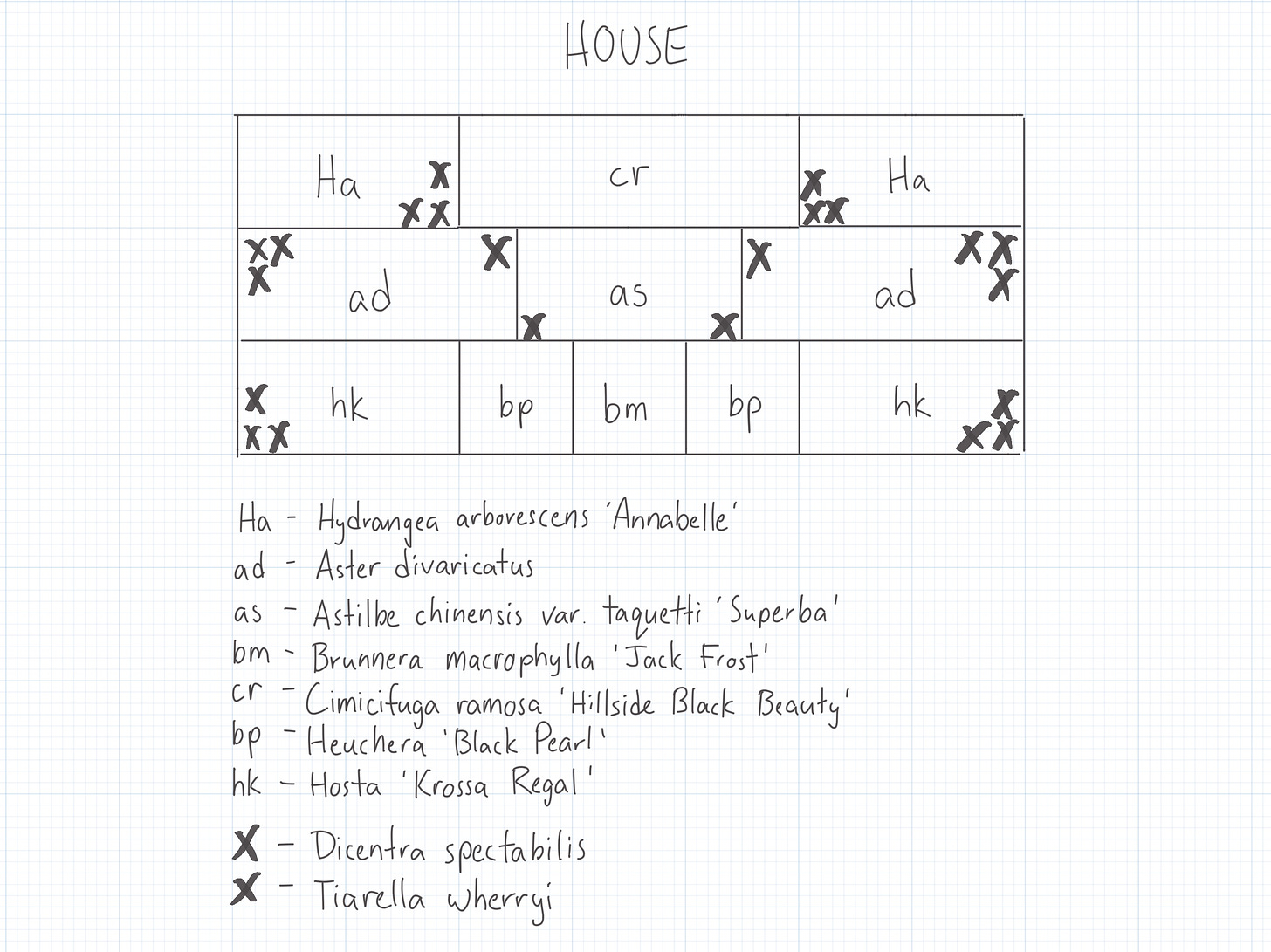
Spring
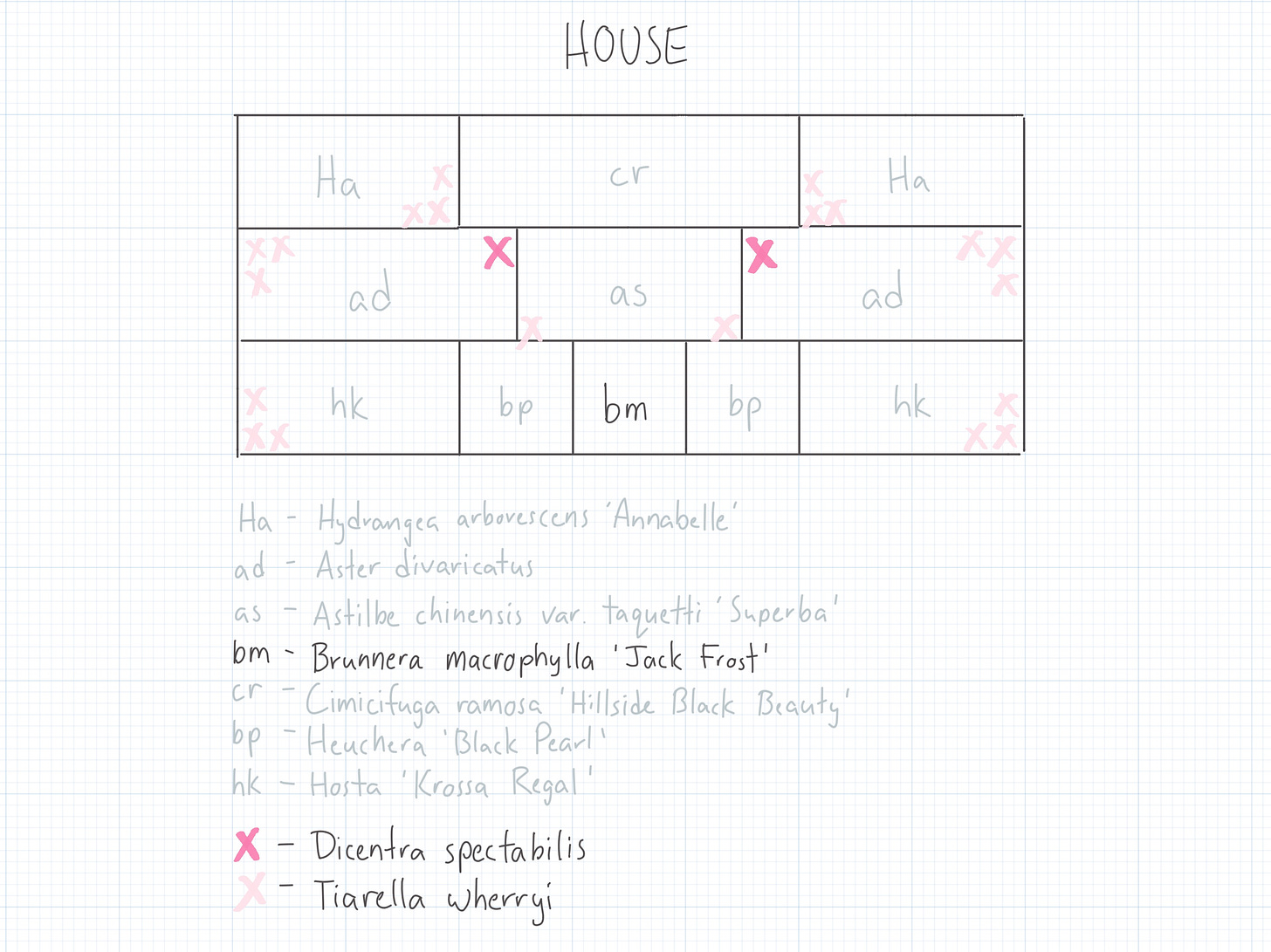
The design is straight forward - tall plants at the back closest to the house foundation, tapering down to the smallest plants in the front. Dicentra is kept to a few small clumps as they usually go dormant in the summer months. If they do, there are other plants around it that will take focus away. Brunnera has a very short flowering time in early spring, but I think it is worth the effort. Their silvery foliage works well with the Hosta and Heuchera so it will still serve a purpose once it’s done flowering through summer and into fall.
Summer
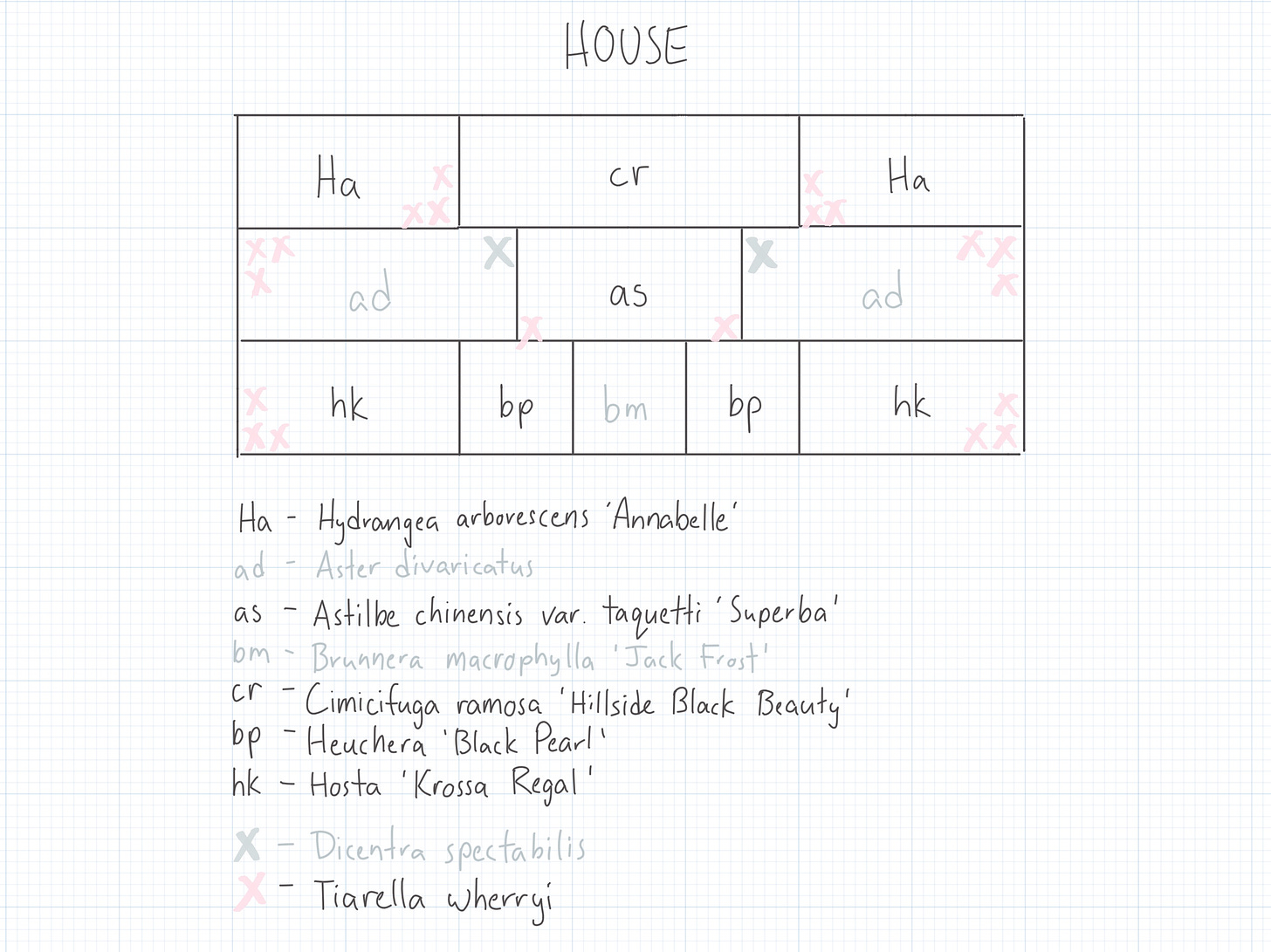
Summer is still your main flowering time for the garden with Astilbe, Cimicifuga, and Hydrangea. They have much larger flowers than the spring plants so the visual impact will be greater.
Fall
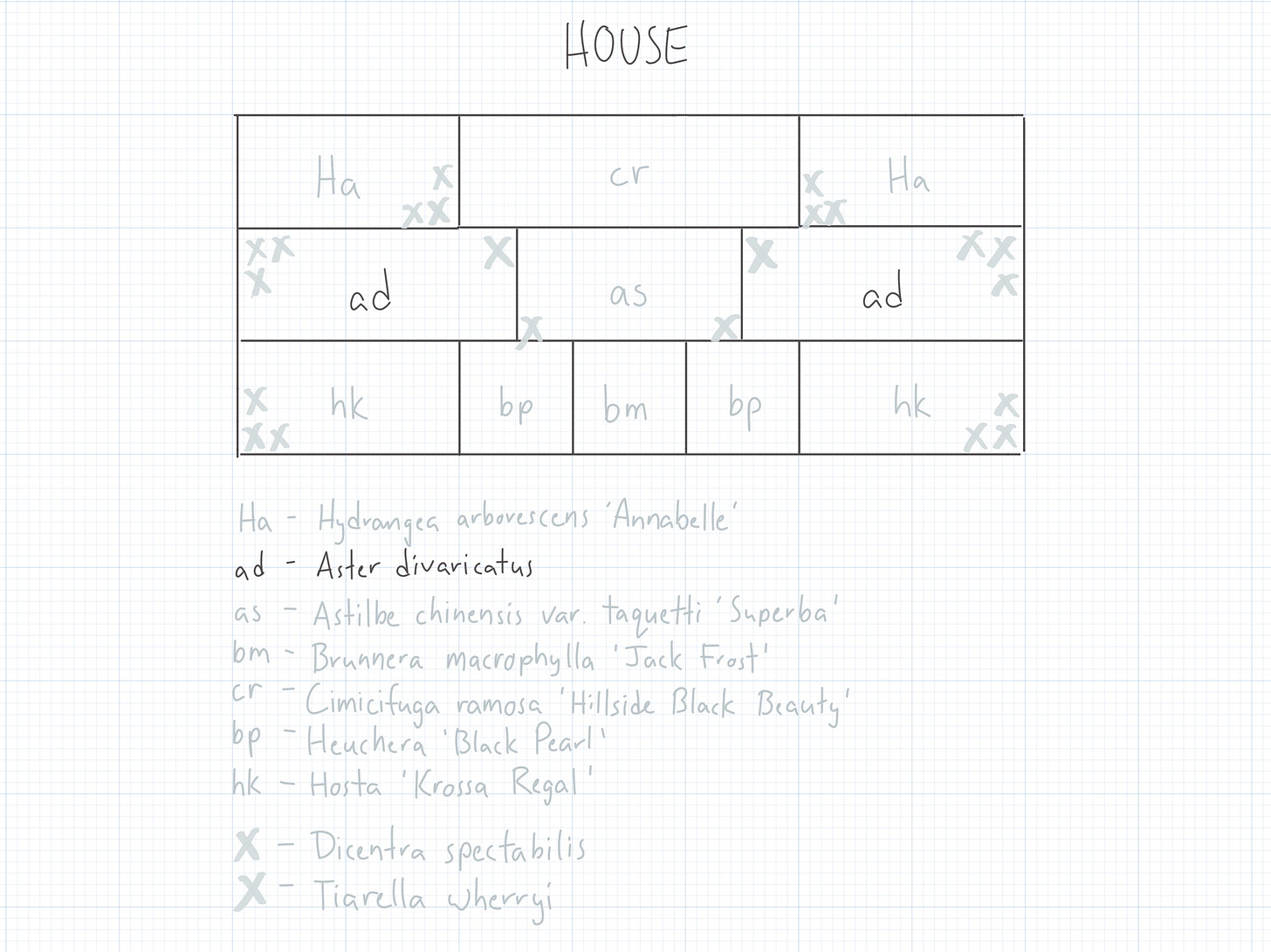
By the time fall rolls around Aster is ready to add some contrast to the strong textures within the garden. It’s a delicate balance of small white flowers with silver, blue, and dark purple foliage from Brunnera, Hosta, Cimicifuga, and Heuchera and dried flowers from Hydrangea and Astilbe. Lots to enjoy!